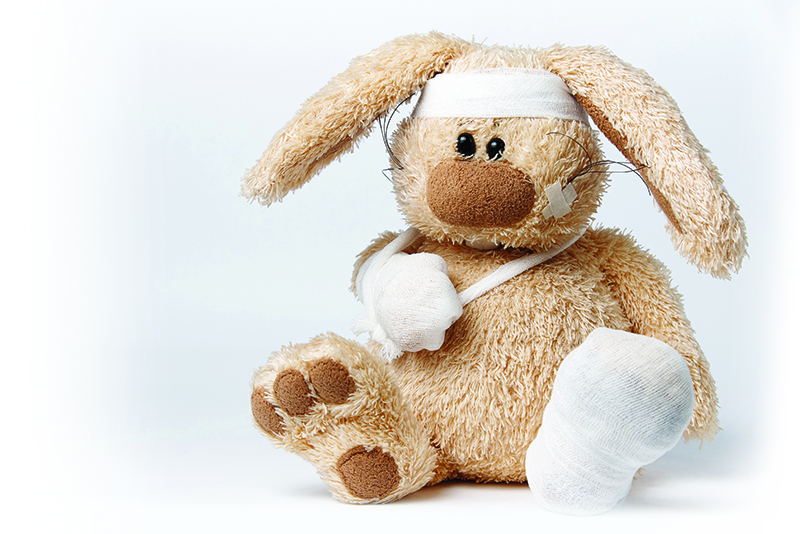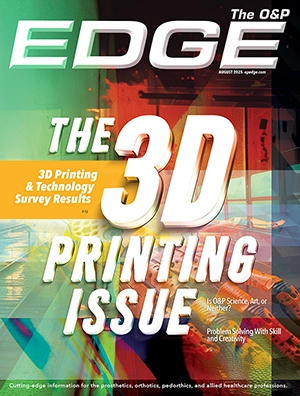 Introduction
Introduction
As O&P practitioners know, a great deal of intention goes into the casting process. The casting water can’t be too hot or too cold, and the material itself has a shelf life. Multiple joints often need to be controlled simultaneously and in all three planes of motion. Care should be taken to accurately capture bony prominences and avoid roping of soft tissues by appropriate tensioning and application of the casting material. Landmarks should be well delineated while avoiding the migration of these marks. The cast also must be appropriately thick in order to maintain structural integrity, but not so thick as to make the removal process difficult. It’s a lot to think about and monitor as the cast sets. Anyone who casts regularly recognizes when one of these points was accidentally neglected and necessitates a recast of the patient. If a nervous, squirmy pediatric patient is being cast, suddenly the game changes entirely.
Through a fortunate combination of wonderful mentors, an interdisciplinary approach, trial and error, and a sense of humor, I’ve come up with a handful of tricks that serve me well for making the pediatric casting process efficient and relatively easy.
Is Casting Necessary?
First things first. Is casting necessary? In many cases, measurements alone will yield adequate results, particularly for small, fleshy patients. A recent HTLSO for a young patient required quite a number of measurements, but it was certainly easier than subjecting her, and her family, to a cast that would have encapsulated two-thirds of her body.
Unusual anatomy and the desire for certain intricacies may be most appropriately captured through casting. When in doubt, I always prefer to cast because I find it yields optimal results. It is worth noting that not every child can tolerate immediate casting, especially more involved children who are fearful of practitioners and with whom you have yet to establish a rapport. This is where the trickery comes into play.
Preparation
For children kindergarten age and younger, I completely throw the term casting out the window. “Let’s do an art project,” I’ll proclaim. I don’t ask, but instead tell the child that I’ll need their help with my art project. The more exciting you can make it sound, the better. As I prepare the items I’ll need to cast, “scary” tools (scissors are an example), are kept out of sight when possible. If you don’t have sufficient pockets, waitressing aprons are an easy, wearable way to hide tools that may be intimidating, while still keeping them easily accessible during the casting process.
At this point in the process, it helps to have example casts. I once cast a child whose family didn’t move forward with orthotic intervention, and I wrapped those casts in an extra layer of casting material. Now I use them as casting examples. As I prepare for my art project, I’ll get out a cast sample to show my young patients, so they can see what our end goal is.
If you have different colored casting materials, this is a great time to bring those options out. Don’t overwhelm your patient with too many options, but offer two or three for them to choose from. If they hesitate, shuffle the colors and let them choose one randomly, so it will be a surprise. Your time is valuable, but that doesn’t mean the casting process can’t still be an enjoyable one. If you have two colors, let them choose which color to use on which foot.
The Casting Process
If I’m casting a child bilaterally or casting multiple body parts (and the patient is able to articulate his or her choice), I like to ask which extremity he or she would like to cast first. Most children appreciate feeling like they still retain some control in a new, somewhat scary situation.
Every practitioner’s casting process varies. The following is what I have found to work well for me. Since holding the casted limb still is necessary, I encourage my patient to “get their wiggles out” by doing a little dance with the extremity I plan to cast. I ask them to wiggle their toes, roll their ankle, pretend to use a hula hoop, etc. I explain that the next step will require them to freeze, so it’s important that they give their extremity a chance to do a little dance now. From there, every stage of the casting process receives a fun pseudonym. Cotton stockinette becomes cozy socks, cut strips are race car slides, and casting material is special art project tape. If my little patient is intrigued enough to watch the process, I may turn some of my bony landmarks into fun shapes such as smiley faces or suns.
It may be helpful to explain to your young patients what sensations they can expect as the casting material sets. You might mention that the while the casting material starts out cold, soon it will become warm, and may even feel like a warm hug. The compression and warmth that comes with a hardening cast may be alarming to some patients, so it’s helpful to proactively address this if you feel your patient is encountering some anxiety over the casting process.
Typically by this point most of the fear over the process is gone, which creates an excellent segue into the next most important task at hand: designing the brace. While the cast is hardening, your patient and his or her family can look at design options and discuss preferences for about the external appearance of the orthosis or prosthesis.
Toddlers and Infants
Unlike preschool and kindergarten-aged patients, toddlers and infants are less likely to be so engaged in the casting process. I find that the quicker you can make this process, the easier it tends to be on the child’s family. While I prepare the supplies I’ll need, I recommend that the family does a diaper check, and gets out any snacks, favorite toys, or devices to serve as distraction. I typically ask a family member to hold the patient in his or her lap, but casting in a high chair can also be useful. Any family present is likely to be engaged in distracting your patient. If everything is going smoothly this is a great time to educate the family on the particulars of the orthosis or prosthesis, including when it will arrive and what to expect at the delivery appointment.
Grade School and Older
In my experience, these patients are more engaged and more likely to watch the casting process. While curious, they aren’t always forthcoming with their questions, so if they seem interested I’ll explain the casting process at each stage in terms that they can understand. For example, I might say, “This cotton sock protects your skin so the cast comes off easily.”
Additional Information
Comfort
In a perfect world, every patient could be cast in a similar position, but in pediatrics that simply isn’t the case. I’ve cast children supine, prone, and side lying, in laps (including my own), in cribs, car seat carriers, and in play forts. Ergonomics are important and shouldn’t be sacrificed for the sake of a good a cast, but some flexibility in your regular process is helpful. Pillows, weighted blankets, and favorite books or stuffed animals may contribute to making the process more comfortable for your patient.
Creativity
For every few handfuls of casts that goes smoothly, there will be one that requires a little more creativity. I love to cast during therapy sessions. Not only does an interdisciplinary approach lend itself incredibly well to optimal O&P management, but these specialists know their patients well. By discussing the most optimal way to cast a particular patient, the process becomes more streamlined and easier on everyone involved. It’s also a great chance to expose our fellow professionals to the level of skill needed to obtain a great impression.
Community
It’s important that patients and their families don’t feel alone. In my clinic I keep stuffed animals wearing prosthetic and orthotic devices much like what I deliver to my real-life patients. Bulletin boards, or brag boards, are a fun place for families to share photos of their children excelling in their new devices, and families new to O&P management love to see these successes. Online or in-community support groups are also helpful resources to share.
(Appropriate) Distractions
Distractions are an important piece of pediatric O&P care, whether that means distracting from the anxiety of the process, or distracting your patient from the casting process altogether. Distractions are especially important for patients who exhibit hypertonia, which may increase with anxiety. Also keep in mind that children with sensory challenges might find traditional distractions overloading to their senses, making the situation worse. Team up with your patient’s caretakers to determine the most appropriate form of distraction, whether that’s eating a meal, reading a book, or watching something on a tablet or smart phone.
Cast removal
While cast saws are an appropriate method of cast removal in both children and adults, noise-reduction headphones should be provided for your patient whenever possible, as a 2017 study by Mehan et al. found these decrease patient anxiety during the cast removal process.
Conclusion
Every patient is different, and just as with adults, there is no one-size-fits-all casting process. While some pediatric patients may benefit from a more thorough and accurate explanation of the process, others are most at ease when the casting is performed quickly and is over with before they have time to build up anxiety. When planning your approach, it’s helpful to ask questions like “Has your child been cast before?” and “Are there any sensory sensitivities that I should be aware of?”
It cannot be emphasized highly enough that the fit of an orthosis or prosthesis can only be as good as the cast that it is built from; therefore, obtaining an excellent cast is of critical importance. When in doubt, don’t be afraid to repeat the casting process if your initial cast is subpar. Taking the time to organize a creative and effective casting approach for every pediatric patient will lend itself to improved patient outcomes. O&P EDGE
Heather Willets, MPO, CPO, is a pediatric-focused prosthetis /orthotist and a member of the American Academy of Orthotists and Prosthetists (the Academy) Lower Limb Orthotics and Gait Societies. She is based in the Denver area.
Academy Society Spotlight is a presentation of clinical content by the Societies of the Academy in partnership with The O&P EDGE.
Support authors and subscribe to content
This is premium stuff. Subscribe to read the entire article.



